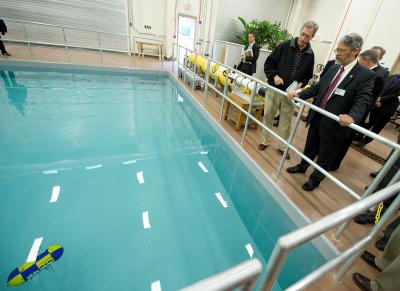Based at the Naval Research Laboratory (NRL) in Washington D.C, the Laboratory for Autonomous Systems Research (LASR) marks the first facility being added to the 130-ac campus of NRL, in ten years.
 Dr. Brian Houston, left, head of the Physical Acoustics Branch at the Naval Research Laboratory(US Navy photo by John F. Williams/Released)
Dr. Brian Houston, left, head of the Physical Acoustics Branch at the Naval Research Laboratory(US Navy photo by John F. Williams/Released)
The LASR facility measuring up to 50,000 sq.ft, represents Earth's ecosystems such as a Littoral High Bay that simulates near-shore waters, a Tropical High Bay prototype resembling southeast Asian rainforests, and a rock wall-integrated Desert High Bay simulating a desert-like environment.
According to the chief of naval research, Rear Adm. Matthew Klunder, this all-inclusive laboratory is a unique facility that manifests the entire marine operation carried out by the Marines, Sailors, and DOD service members of NRL. The main objective of the Office of Naval Research is to continue furtheradvancement in robotics and autonomy. It provides expedite delivery of solutions required by NRL’s warfighters performing critical missions. With the introduction of this innovative facility, there is an easy access to in-the-field experimentation with time and cost-efficiency.
The LASR building, worth $17.7 M was unveiled on March 16. LASR is the key center in the Department of Defense for carrying out robotic systems research. It functions as an effective platform for a variety of scientists, researchers and engineers in different disciplines to devise on meeting the autonomy challenges existing in the nation.
The lab's facilities already have several multidisciplinary projects functioning in it to perform major researches such as Damage Control for the 21st Century, which is a project, intended to develop firefighting robots for widespread naval applications. Some of the innovations at the facility include an underwater robot called Pectoral Fin Swimmer and hydrogen fuel cell propulsion to power a small unmanned aircraft called Ion Tiger.